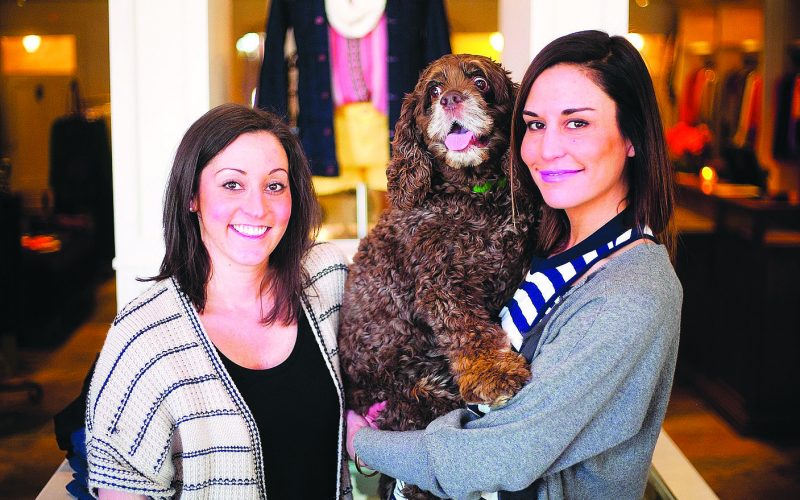
Photo By Celi Birke
Danielle Vaughan, Milo and Jade Terminella pose for a photo at Lola Boutique. Jade’s concept of fashion for philanthropy was inspired by her love for animals.
By Terrah Baker
What began as a fleeting conversation between boutique owner Jade Terminella and former Celebrate magazine advertise sales person Danielle Davis Vaughan, has become the NWA fashion event of the year in what seems like overnight. After just one year of fashion frenzy and collaboration, their donation goals tripled — from $35,000 to $100,000 — models had to pay a registration fee, they added eight benefitting nonprofit groups, and prices to show the same amount of looks as the year before increased times three.
For the founders, large sponsors such as Mercedes-Benz of Northwest Arkansas and L’Oreal, and some small boutiques and designers trying to get their name out there, the growth is a welcome change. But a small group of local designers say they’re not happy with the direction Fashion Week took in its second year, and want to keep their artistic voice heard in the community. Something they said they weren’t allowed to do within the fashion week planning committee, chosen by Terminella and Vaughan.
“We got involved last year in fashion week because it was the first year and we thought it was a great opportunity,” said Wayne Bonner-Bell of BonnerBell designs. “We thought it would be a great avenue to launch our brand.”
Terminella and Vaughan think it did that, and Bonner-Bell said along with his artistic creations, he agrees. He gained three long-term and two one-off accounts following last year’s show, along with name and logo recognition throughout the community.
But when it came time to start planning for 2013, Bonner-Bell said he and others were told to leave the planning to the committee. So, when the website was launched in October, Bonner-Bell and several designer colleagues were surprised to see such a large price increase for a full show from $500 to $1,500.
Terminella said at one of the final pre-fashion week meetings they never expected to please everyone, and the main focus was on the customers, who will ultimately be paying the nonprofit groups through their ticket purchase. The argument by several local designers was they did this at the expense of local artists that were such a large part of why the original show was so popular.
“The pricing structure going up coupled with the fact that our requests to be accepted on the committee were never answered. The fact that models were being charged (a $20 registration fee) to walk …” Bonner-Bell said. “These are the things that bothered us.”
To determine the price for designers to have a full line, Terminella and Vaughan took the worth of all donated and purchased items needed to put on the show, and divided it by the number of participants — all of which Terminella and Vaughan said benefitted from the exposure. This, coupled with shows running too long, an abundance of models, designers and boutiques wanting to participate, choices had to be made to narrow down the selection, they said.
For Lauren Embree of Lauren Embree Jewelry designs, the high price and lack of inclusion also made it hard for her to be involved. At least three local designers who participated last year chose not to be included in 2013 because of the changes.
Organizers set up a tiered system for those who couldn’t afford the full show fee, but the options didn’t allow designers with smaller budgets a chance for decent exposure — for $500 a designer would get eight looks that lasted only minutes on stage, Embree said.
“Very few people make money (designing). We do it because it’s our passion and it’s our art,” Embree said. “They said if a boutique can afford it, then you should be able to also. Myself … Wayne, we’re doing everything from conception to purchasing materials, to manufacturing and creating and marketing and putting together an entire collection. It’s not comparable.”
Others still worry about the designation of Fashion Week as a Limited Liability Company instead of a nonprofit group, meaning any money made is claimed as personal income to the owners and can be used for a large tax write-off, especially if the $100,000 donation goal is met.
Terminella and Vaughan said all of the profit after costs go to the charities and nonprofit groups, originally chosen by the planning committee, and numbers will be made available following the show.
The two offered their assistance in finding business sponsors for designers who couldn’t afford a full show, but designers who chose not to take part went back to having their own show for 2013 — what designers were doing before last year’s fashion week (Terminella said there had been about 32 shows in 2011).
While these local artists wish it had stayed focused on the art of local designers and open collaboration, for the over five designers, over 22 boutiques, 26 sponsors, photographers, film crews, organizers and nonprofit groups involved, this will prove another successful year, as the first night of the show was sold out two weeks prior.



